Finding tiny black bugs on your bed sheets is a cause for concern. Do they bite? Will they cause sickness or harm to your family? How did they get there? These are just some of the questions that may run through your mind. This article will discuss how to get rid of tiny black bugs that are commonly found on bed sheets.
The tiny black bugs found on bed sheets are:
Black Carpet Beetle
Wood Ticks
Swallow Bug
Spider Beetle
Batbug
Fleas
Cockroach Nymphs
Book Louse Bug
Fortunately, you can avoid an infestation by making sure your home and pets are always clean.
But before learning how to get rid of them, it is helpful to learn to identify which bug you’re dealing with first. From there, it will be easy to address the cause of the infestation. Read on to know more about each of these tiny black bugs.
Tiny Black Bugs on Bed Sheets | Identification, Habitat, and Control
Black Carpet Beetle
The black carpet beetle is a common tiny black bug you can find around the house – especially if you have a carpet. These bugs munch on a variety of fabrics, including wool and silk. That’s why they can also infest bed sheets.
Unfortunately, these beetles lay around 50 to 100 eggs. That can easily lead to an infestation once they hatch. Thus, it’s best to stop its spread before the eggs hatch.
- Appearance: Black carpet beetles are small insects with oval-shaped bodies. Its color is either black or dark brown, with its outer shell looking shiny. It has three pairs of legs and a pair of long antennae.
- Size: 1/8 to 3/16 inches
- Scientific Name: Attagenus unicolor
- Lifespan: 4 to 8 weeks
- Habitat: Soil, under rocks, logs, and leaves
- Diet: Leather, wool, silk, feathers, hair, dried meat, dead insects, and dried plant
- Threat: Black carpet beetles do not bite. However, they love munching on carpets and other similar fabrics. This can create quite an eyesore – or cause welts on your sheets which can lead to discomfort.
- Control: Prevention is always better than cure. To avoid a black carpet beetle infestation, make sure to regularly clean your bed sheets to prevent them from making a nest there. It also helps to have your sheets steamed to get rid of any eggs.
Wood Ticks
Wood ticks, also known as the American dog tick, are the common parasite that you can find on warm-blooded household pets. They have eight legs, which means that they are arthropods, although they are often misidentified as insects.
- Appearance: Wood ticks are characterized by their flat, oval-shaped bodies that appear dark red or reddish brown. However, a female wood tick turns gray or green-gray when it is engorged with blood and ready to mate.
- Size: 3/16 inches
- Scientific Name: Dermacentor andersoni
- Lifespan: 3 to 5 months
- Habitat: Woodland paths, parks, pastures, and backyards
- Diet: The blood of mammals, birds, and reptiles
- Threat: By itself, a wood tick doesn’t always bite humans. But when they do, their bites are often harmless, although these can be itchy. However, wood ticks can be carriers of certain bacterial diseases like the Rocky Mountain Spotted Fever or Lyme disease.
However, the same may not be the case for your furry friends. Wood ticks often host warm-blooded animals like cats and dogs, and an infestation could lead to anemia and even paralysis. This is in addition to other bacterial infections or diseases that a carrier wood tick can transfer to your pet.
- Control: Wood ticks may get to your bed sheets whenever you allow a host pet to take a nap on your bed. The very first step you have to do to prevent it is by making sure that your pet doesn’t have any wood ticks. You can use anti-tick soaps, shampoo, and powder to keep these tiny arthropods away from your furry friend.
Related: Are Wood Ticks Dangerous? | Important Facts
Swallow Bug
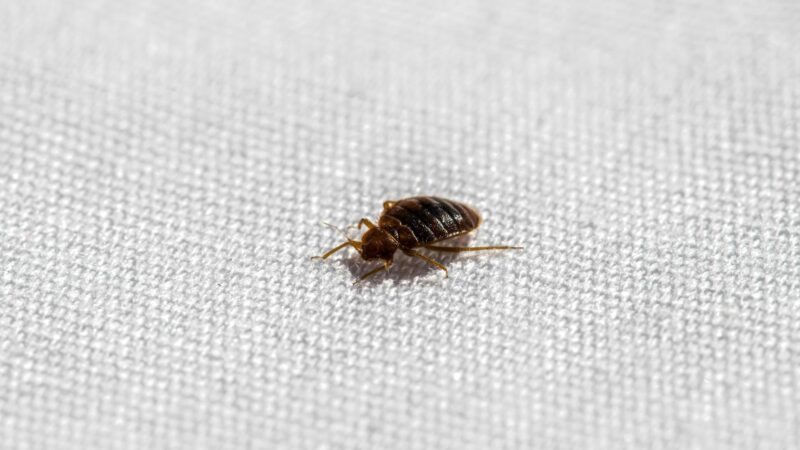
Swallow bugs, also known as American swallow bugs or cliff swallow bugs, are blood-feeding insects. It is so named because it commonly hosts swallows and other wild birds. These bugs are often mistaken for bed bugs, but they are often smaller and with a more grayish appearance.
- Appearance: Swallow bugs are tiny insects with plump and round-shaped bodies. They often appear grayish-brown or yellowish-brown and share a close resemblance to the bed bug. However, they are smaller than bed bugs and have a layer of fine, bristle-like hair.
- Size: 3/16 inches
- Scientific Name: Oeciacus vicarius
- Lifespan: 2 to 3 years
- Habitat: Grassland, marshes, marshes, and any similar areas where you can find cliff swallow nests
- Diet: Birds
- Threat: Swallow bugs do bite. While their primary hosts are swallows and other wild birds, they can also host humans. Unfortunately, their bites can be itchy, while some can even trigger allergic reactions.
- Control: Swallow bugs do not often cause infestations in urban and suburban areas since it is often found in the wild. But it can reach your home if it attaches to your bags or clothes whenever you go outdoors. To prevent its spread, make sure to keep your dirty clothes away from your bedroom and have them cleaned as soon as possible.
Also, check the perimeter of your home if there is a bird’s nest nearby. In case one is nearby, swallow bugs can easily make their way and infest your home. In this case, it’s best to call the authorities to have the nest relocated.
Spider Beetle

The spider beetle is a flightless scavenger insect that feeds on plant-based food products such as grains, almonds, and wheat. They are commonly found in pantries where food is usually stored.
- Appearance: The spider beetle looks like a tiny spider with a plump oval-shaped body. They are so named because they have three pairs of legs and two long antennae that look like legs – and that gives them the appearance of having eight legs. They are usually reddish-brown or dark red.
- Size: 1/16 to 1/8 inches
- Scientific Name: Ptininae
- Lifespan: 1 year
- Habitat: Pantries, museums, grain mills, warehouses, and attics
- Diet: Seeds, grain debris, herbs, dried fruit, and fungi
- Threat: While spider beetles do not bite, they can chew holes in food packaging. This not only damages the container but can also spoil the food inside. Additionally, they are known to munch on fabrics which can cause quite a lot of damage.
- Control: To prevent a spider beetle infestation, make sure to clean your pantry regularly. In case of an infestation, get rid of all the affected food and packaging. If you love snacking in bed, make sure to clean and vacuum your bed sheets to prevent spider beetles from being attracted to the crumbs and leftovers.
Batbug
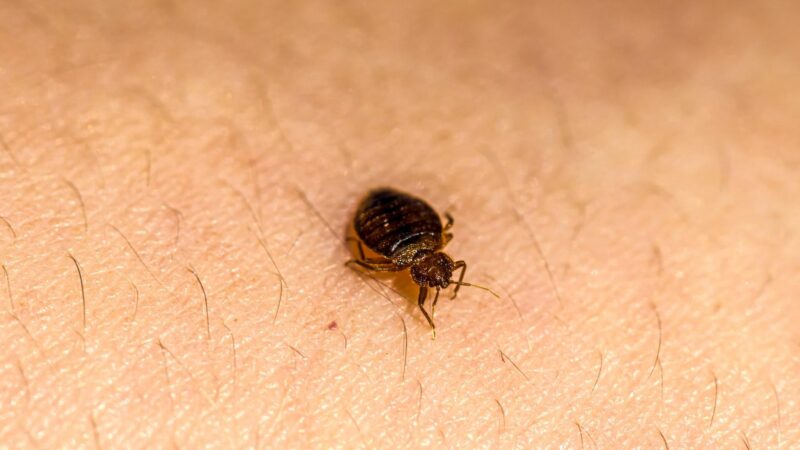
The batbug is another tiny black bug that’s commonly found on bed sheets. Otherwise spelled as bat bugs, these parasitic insects prefer feeding on the blood of mammals. It prefers the blood of bats and would often be found where bats often nest. However, it has made its way into urban areas where bats have grown accustomed – such as in old buildings or parks.
- Appearance: The bat bug shares a resemblance with the common bed bug. It has a flat oval-shaped body that’s either red or reddish brown – but still visibly lighter than bed bugs. And upon close inspection, bat bugs also have thicker legs than bed bugs.
- Size: 0.14 and 0.2 inch
- Scientific Name: Cimicidae
- Lifespan: 9 months
- Habitat: Mattresses, box springs, bed frames, and furniture
- Diet: Blood from bats
- Threat: Be reminded that a bat bug’s primary food source is the blood of mammals. While it prefers the blood of bats, it won’t hesitate to bite and suck human blood if that’s what’s available. Their bites can cause skin irritation and can even trigger allergic reactions. As such, it’s best to get rid of bat bugs as soon as possible.
- Control: Bat bugs do not normally enter a person’s home unless you have been to a place where bats live. In that case, it may have adhered to your clothes, shoes, or bags. In this case, don’t go straight to your room as soon as you get home. Make sure all your things are thoroughly cleaned to make sure that you have not brought any bat bugs into your home.
In case you already have an infestation at home, experts advise using an aerosol bomb or an insecticide treatment to eliminate bat bugs once and for all. With them dead, make sure to clean your home thoroughly, especially paying attention to cracks and crevices where they may be hiding.
Fleas
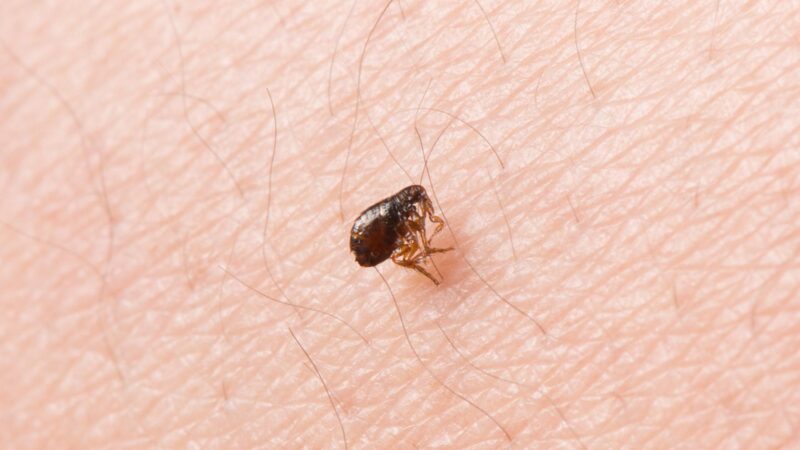
Fleas are another small parasitic tiny black bug that you can commonly find on your bed sheets – especially if you have pets. These wingless insects often feed on the blood of their host animal but may also bite humans if no other host is nearby.
Unfortunately, a single flea can lay up to 50 eggs per day which last for around 50 days. And these eggs can fall off your pet when it shakes or scratches. That’s how it can easily lead to an infestation on your bed.
- Appearance: Fleas have oval-shaped yet plump bodies. They often appear reddish brown or dark brown. A notable feature is its long legs and rounded heavy bottom.
- Size: 1/8 inch
- Scientific Name: Siphonaptera
- Lifespan: 2 or 3 months
- Habitat: Warm-blooded animal
- Diet: Blood from humans and pets
- Threat: Aside from its quick reproduction that could easily lead to an infestation, fleas can be carriers of diseases. This is in addition to their painful and itchy bites – some of which can trigger severe allergic reactions.
- Control: To make sure that you don’t get a flea infestation at home, it’s best to always bathe your pet with anti-flea soap, shampoo, or powder. This is especially done after your pet has been out for a walk or has been to the dog park. This is to ensure that no flea is to enter your home and start a dreaded infestation.
Related: 8 Signs of Fleas in Bed and How to Get Rid of Them | A Complete Guide
Cockroach Nymphs
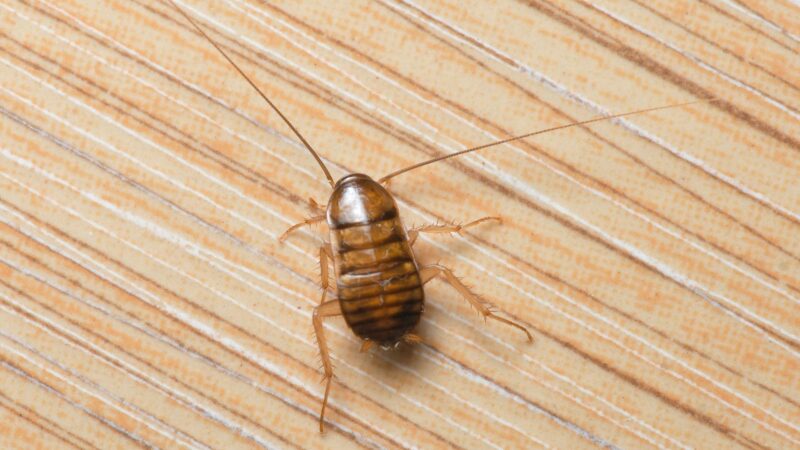
Cockroach nymphs are the newly-hatched baby cockroaches. These are the tiny wingless versions of the adult cockroach. But while they are flightless, they can similarly spread diseases like their adult versions.
- Appearance: Cockroach nymphs look like tiny cockroaches – they have elongated bodies, three pairs of legs, and a pair of long antennae. They usually appear dark red, reddish brown, or bright maroon.
- Size: 3/4 inch
- Scientific Name: Blattella
- Lifespan: 6 to 15 months
- Habitat: Hollow trees, wood piles, and mulch
- Diet: Sweets, meats, and starches
- Threat: Cockroach nymphs are common pests known for being a health hazard. They can carry diseases because of their scavenging nature, often eating whatever’s available – even their feces if no other food is around. They also bite when they are threatened, and these bites can be swollen and painful.
- Control: In case of an infestation, you can diffuse citrus oils in your bedroom since cockroaches are known to be repulsed by that scent. To prevent the recurrence of an infestation, make sure your room – especially your bed sheets – is always clean. If you love snacking in bed, always vacuum right after eating to get rid of any leftovers that can further attract cockroach nymphs. It also helps to clean the entire house to make sure no cockroach nymphs or eggs remain hidden.
Book Louse Bug
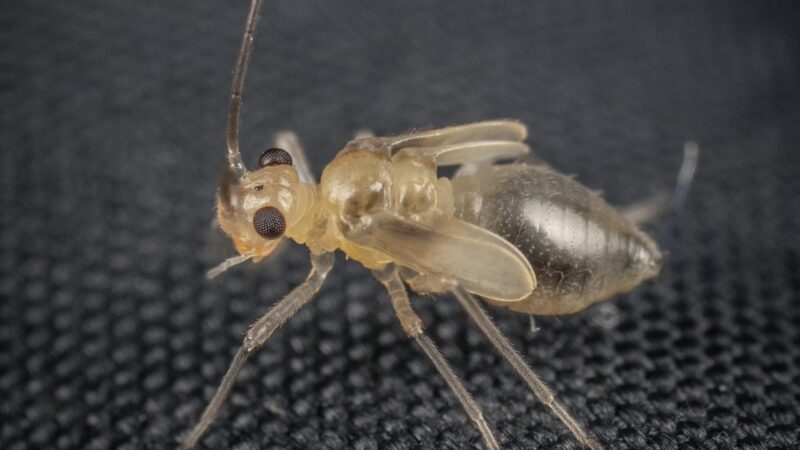
The book louse bug is one of the hardest tiny bugs to spot because of its pale-colored body. Otherwise known as booklice, the book lousebug is known to munch on paper products, including the glue that binds books together. They’re primarily drawn to moist and moldy areas.
- Appearance: Book louse bugs are tiny insects with elongated bodies that are shaped like bowling pins. They have six transparent-looking legs and a pair of thin and long antennae. Their bodies are usually reddish-brown, while others appear pale brown and a bit translucent.
- Size: 1/16 inch
- Scientific Name: Psocoptera
- Lifespan: 24 to 110 days
- Habitat: Books and papers
- Diet: Mold, fungi, grains, insect fragments, and other starchy material
- Threat: The book louse bug does not bite humans or animals, but it can cause great damage to books and other paper products.
- Control: Book louse bugs are attracted to moist areas, so if your house has a leak and has developed molds, expect a book louse bug infestation soon. To get rid of them, you have to dispose of the affected materials, get rid of molds, and address the source of the leaks. And to prevent its recurrence, it’s best to invest in a dehumidifier to prevent the growth of molds.
What Causes Tiny Black Bugs On Your Bed?
Food crumbs. These tiny black bugs are continuously in search of food. So, they are attracted to areas where they can find food – especially starchy ones like french fries and bread. So if you love snacking on your bed, make sure to thoroughly clean right after to prevent these bugs from taking over your sheets.
Pets. Some of these bugs are parasitic and often dwell on animals – such as fleas on dogs. If your pet suffers from a bug infestation, it may leave some bugs on your bed whenever it takes a nap.
Dirty clothes. Sometimes, these bugs may have attached to your clothes while you were out and made their way to your bed when you left your dirty clothes on or near your bed.
Do Tiny Black Bugs On Bed Sheets Bite?
Some of these tiny black bugs do bite. While these bites are not harmful, some of them can be itchy and irritating. It can also cause swelling on the site of the bite. On the other hand, some bugs do not bite, but they can damage the fabric of your bed sheets – which can be annoying.
How to Treat Tiny Black Bug Bites?
Wash the area. The very first thing that you should do as soon as you get bit by these bugs is to clean the area with soap and water. This ensures that the bite site is clean to prevent any further infection.
Apply an anti-itch cream. While bug bites are usually harmless, they can be itchy and irritating. In this case, it’s best to apply an over-the-counter anti-itch cream for immediate relief.
Take an anti-allergy medicine. Sometimes, these bugs can cause an allergic reaction, especially in the immunocompromised population. In this case, it’s best to take antihistamines to prevent further complications.
How to Eliminate Small Black Bugs With Hard Shell in Your House Naturally?
Aside from the tiny black bugs on your bed sheet, you can also find small black bugs with hard shells around your house. These can be quite bothersome, especially if they’re already causing damage to your property. Fortunately, you can easily eliminate them naturally by using the following tips:
- Peppermint. Bugs and insects are repelled by the smell of peppermint. There’s just something about its strong scent that drives them away, so lighting a peppermint-scented candle or diffusing peppermint oil will surely keep these bugs away.
- Clean your food pantry regularly. These bugs are attracted to food sources, so if there are crumbs scattered around your pantry, then they will surely be drawn to it. Make sure all your food is kept in airtight containers so they won’t be drawn to its smell.
- Get rid of leaks and stagnant water sources. Aside from food sources, bugs are also attracted to water and molds. If you have a leak in your home, expect bugs like cockroaches to thrive in it. To eliminate these bugs, check your water pipes to make sure that there are no leaks. Also, get rid of any stagnant water to keep them from coming back. In the case of flowers in vases, make sure to change the water regularly.
- Clean your house regularly. It also bears stressing that a clean house will not attract any of these bugs. By cleaning your house regularly, you’re also getting rid of these bugs’ eggs, which will surely help you avoid a potential infestation.
All things considered, there are several tiny black bugs that you can find on your bed sheet. These are the Black Carpet Beetle, Wood Ticks, Swallow Bug, Spider Beetle, Batbug, Fleas, Cockroach Nymphs, and the Book Louse Bug. And as long as you know which bug you’re dealing with, avoiding an infestation will be easy.
List of Sources
Adelman, Z. N., Miller, D. M., Myles, K. M. (2013). Bed Bugs and Infectious Disease: A Case for the Arboviruses. PLoS Pathogens.
Cranshaw, W. S., Ewals-Strain, B. (2020). Bed Bug Lookalikes – Bat Bugs and Swallow Bugs in Colorado. Colorado State University Extension.
Cranshaw, W. S., Camper, M., Peairs, F. B. (2013). Bat Bugs, Bed Bugs, and Relatives. Colorado State University Extension. Available at https://extension.colostate.edu/topic-areas/insects/bat-bugs-bed-bugs-and-relatives-5-574/ (Accessed 12 September 2022)
Rahlenbeck, S., Fingerle, V., Doggett, S. (2016). Prevention of tick-borne diseases: an overview. British Journal of General Practice.
Hahn, J., Kells, S. (2019). Psocids (barklice, booklice). University of Minnesota Extension.
- How to Get Rid of Copperheads | Practical Guide - August 27, 2023
- How to Get Rid of Corn Snakes | What Makes Them Aggressive? - August 27, 2023
- How to Get Rid of Alligators | Safety Measures and Removal Methods - July 16, 2023
